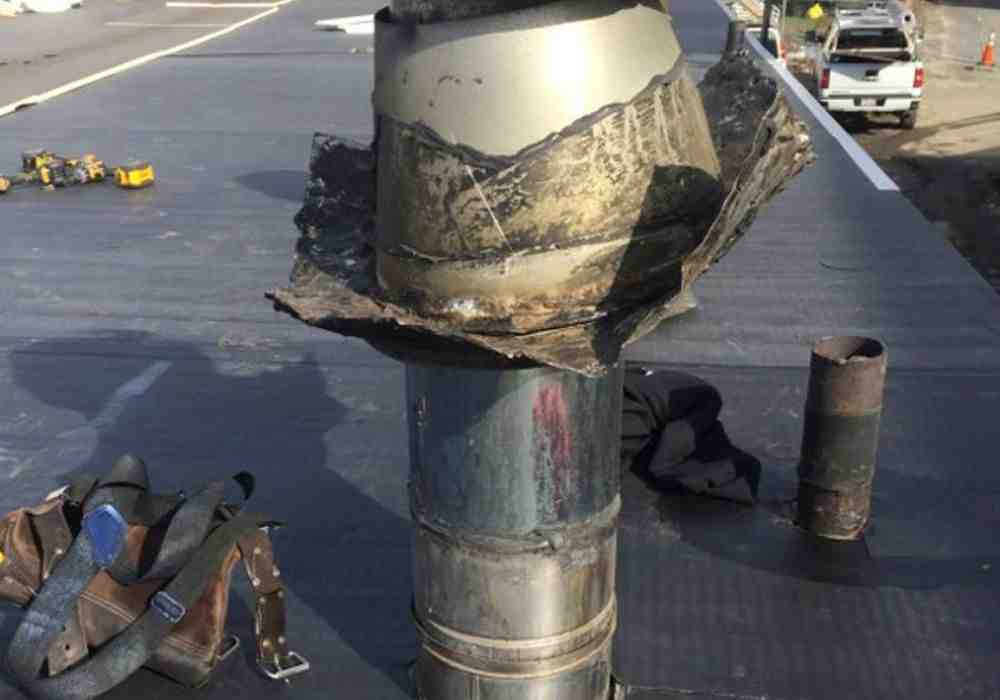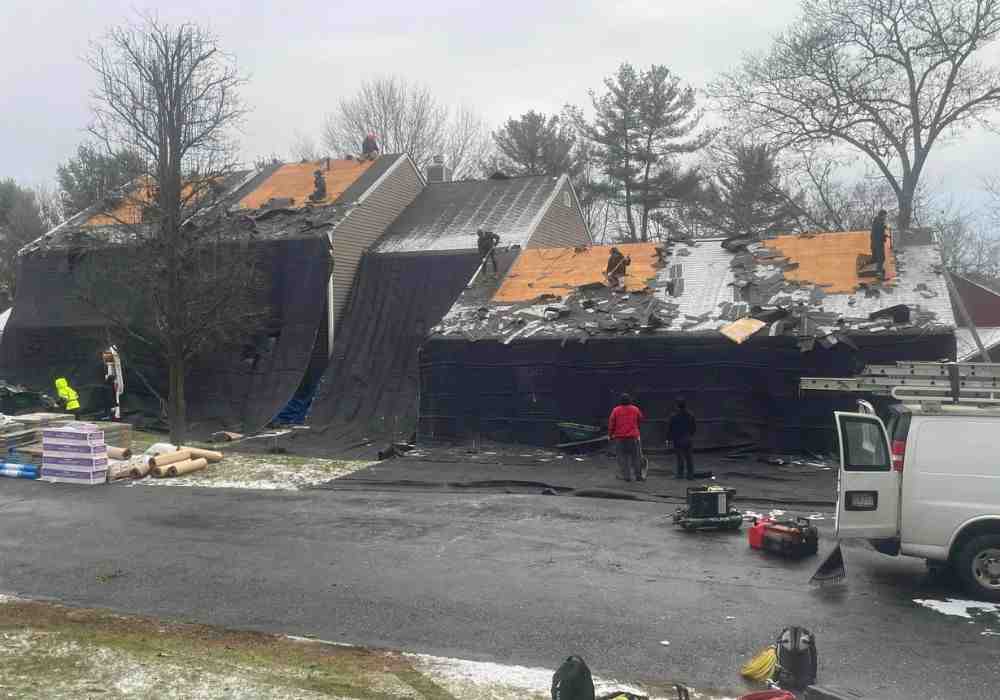Why Roof Replacement is Important
When it comes to maintaining your home’s structural integrity, roofing replacement is a crucial aspect that you should not overlook. Whether your needs involve a complete roof replacement, a simple roof repair, or ongoing roof maintenance, understanding these processes can save you both time and money in the long run.
For those in a hurry, here’s a quick breakdown:
Roofing Replacement:
– Ideal for extensive damage or aging roofs
– Boosts home value and energy efficiency
– Costs vary by material and size
Roof Repair:
– Best for minor leaks or localized damage
– Faster and budget-friendly
– Suitable for newer roofs with isolated issues
Roof Maintenance:
– Prevents costly repairs and prolongs roof life
– Involves regular inspections and cleaning
I’m Kevin McLaughlin, owner of Heritage Exteriors LLC. With a lifetime of experience in roofing, I have overseen countless roofing replacement projects. My dedication is to uphold the highest quality and ensure customer satisfaction in every job we undertake.

Understanding Roof Replacement
What is Roof Replacement?
Roof replacement involves completely removing the existing roofing system and installing a new one. This process is essential when a roof is too damaged or aged to be repaired effectively. Unlike reroofing, which involves adding a new layer of shingles over the existing ones, roof replacement ensures the entire roofing structure is renewed, providing a fresh start.
Reroofing can be a quicker and less expensive option, but it’s not always suitable, especially if the roof has multiple layers or severe underlying damage. Roof replacement, on the other hand, addresses all issues from the ground up, ensuring long-term durability and performance.
Signs You Need a Roof Replacement
Recognizing the signs that your roof needs replacement is crucial for maintaining your home’s integrity. Here are the key indicators:
1. Roof Leaks: Persistent leaks are a clear sign that your roof’s protective barriers have been compromised. Water stains on ceilings or walls often indicate a failing roof that needs immediate attention.
2. Missing Shingles: Shingles protect your roof from the elements. If you notice shingles missing or find pieces of shingles in your yard, it’s a sign that your roof is deteriorating.
3. Roof Lifespan: Most asphalt shingle roofs last between 20 to 25 years. If your roof is approaching this age, it’s time to consider a replacement, even if it appears to be in decent condition.

4. Roof Inspection: Regular inspections can reveal hidden issues. A professional roof inspection will assess the condition of your shingles, flashing, and underlayment, providing a detailed report on whether a repair or replacement is necessary.
5. Curling or Clawing Shingles: When shingles start to curl or claw, it’s a sign of aging and potential leaks. These issues can be caused by poor ventilation or weathering and typically indicate the need for a new roof.
6. Granules in Gutters: Finding granules in your gutters is normal for a new roof, but excessive granules can signal that your shingles are deteriorating and losing their protective coating.
7. Sagging Roof: A sagging roof is a serious issue that suggests structural damage. This could be due to prolonged water damage, poor installation, or excess weight from multiple layers of roofing materials.
8. Increased Energy Bills: If you notice a spike in your energy bills, it could be due to a failing roof losing its insulation properties. A new roof can improve your home’s energy efficiency.
By understanding these signs and regularly inspecting your roof, you can take proactive steps to maintain your home’s integrity and avoid costly repairs.
Next, we’ll delve into the different types of roofing materials available for your roofing replacement project.
Types of Roofing Materials
Choosing the right roofing material for your home is crucial. It impacts the cost, durability, and overall look of your roof. Let’s explore some common options:
Asphalt Shingles
Asphalt shingles are a popular choice for many homeowners. They are cost-effective and come in various styles and colors. This makes them easy to match with your home’s aesthetic.
- Lifespan: Typically last 20-30 years.
- Installation: Easy to install and maintain, but may require occasional repairs due to weather damage.
Metal Roofing
Metal roofing is known for its durability and energy efficiency. It can reflect sunlight, which helps reduce cooling costs in the summer.
- Lifespan: Can last up to 70 years.
- Fire Resistance: Highly resistant to fire, making it a safe option.
- Installation: Available in various styles and colors, including panels and shingles.
Tile Roofing
Tile roofing offers an aesthetic appeal that many homeowners love. It’s particularly beneficial in hot climates as it reflects sunlight and keeps homes cooler.
- Types: Includes both clay and concrete tiles.
- Lifespan: Can last up to 50 years or more.
- Maintenance: Requires minimal maintenance but can be heavier, needing a strong roof structure.
Slate Roofing
Slate roofing is considered a luxury option due to its high cost and elegant appearance. It’s incredibly durable and can last over 100 years.
- Material: Made from natural stone.
- Durability: One of the most durable roofing materials available.
- Aesthetic Appeal: Offers a distinctive, high-end look.
Wood Shake Roofing
Wood shakes provide a natural look and excellent insulation. They are ideal for those who want a rustic, traditional appearance.
- Lifespan: Typically last 20-40 years.
- Fire Resistance: Some cedar shakes are pressure-treated with fire retardants.
- Maintenance: Requires regular maintenance to prevent mold, rot, and insect damage.
Each roofing material has its own set of benefits. Consider your budget, climate, and personal preferences to make an informed decision for your roofing replacement project.
Next, we’ll discuss the costs involved in a roof replacement.
Cost of Roof Replacement
When considering a roofing replacement, understanding the costs involved is crucial. Several factors can impact the overall expense, from the size of the roof to the type of materials used. Here’s a breakdown to help you plan your budget effectively.
Factors Affecting Roof Replacement Cost
1. Roof Size
The size of your roof is one of the most significant factors. Larger roofs require more materials and labor, which increases the cost.
2. Material Type
Different roofing materials come with varying price tags. For example, asphalt shingles are generally more affordable than slate tiles.
3. Labor Costs
Labor costs can vary depending on the complexity of the job and the experience of the contractors. Steeper roofs or those with many features like chimneys and skylights may require more labor.
4. Permits
Depending on your location, you may need permits for a roof replacement. These can add several hundred dollars to the overall cost. Always check local regulations to ensure you have all necessary permits.
5. Additional Costs
Other costs can include equipment rentals, safety gear, and cleanup and disposal of old materials. These should be factored into your overall budget.
Average Costs by Material
Here’s a look at the average costs you can expect for different types of roofing materials:
1. Asphalt Shingles
– Cost: $8,000 – $17,000 for a 2,000-square-foot home
– Lifespan: 20-30 years
– Maintenance: Easy to maintain but may require occasional repairs
2. Metal Roofing
– Cost: $14,000 – $34,000
– Lifespan: Up to 70 years
– Benefits: Highly durable and energy-efficient
3. Tile Roofing
– Cost: $15,000 – $40,000
– Lifespan: 50 years or more
– Types: Clay and concrete tiles
4. Slate Roofing
– Cost: $19,000 – $52,000
– Lifespan: Over 100 years
– Benefits: Extremely durable and aesthetically appealing
5. Wood Shake Roofing
– Cost: $14,000 – $32,000
– Lifespan: 20-40 years
– Maintenance: Requires regular upkeep to prevent mold and rot
Understanding these costs and factors will help you make an informed decision about your roofing replacement. Next, we’ll walk you through the entire roof replacement process.
Roof Replacement Process
Replacing a roof is a big project, but understanding each step can make it less daunting. Here’s a clear breakdown of the roof replacement process:
Initial Inspection and Consultation
Roof Inspection
The first step is a thorough roof inspection. A professional will visit your property to assess the roof’s condition. This includes checking for:
- Missing or damaged shingles
- Leaks and water stains
- Mold or moss growth
- Sagging roof deck
- Granule loss
Example: Imagine a homeowner in Texas who noticed water stains on their ceiling. During the inspection, the roofer found several missing shingles and significant granule loss, indicating it was time for a replacement.
Damage Assessment
After the inspection, the roofer will document any issues and discuss them with you. They will explain whether a repair or a full replacement is necessary. If the damage is extensive or the roof is nearing the end of its lifespan, replacement might be the best option.
Consultation
During the consultation, you can ask questions and understand your options. The roofer will provide a detailed estimate, including:
- Type of roofing material
- Estimated time to complete the work
- Cleanup and disposal costs
- Additional costs like permits or necessary repairs
Choosing the Right Materials
Material Selection
Selecting the right material is crucial for both cost and durability. Common roofing materials include:
- Asphalt Shingles: Cost-effective and easy to install.
- Metal Roofing: Durable, fire-resistant, and energy-efficient.
- Tile Roofing: Long-lasting and aesthetically pleasing.
- Slate Roofing: Extremely durable and offers a high-end look.
- Wood Shake Roofing: Natural appearance but requires regular maintenance.
Cost Considerations
Each material has its own price range. For example:
- Asphalt Shingles: $5,000 – $10,000
- Metal Roofing: $15,000 – $30,000
- Tile Roofing: $15,000 – $40,000
- Slate Roofing: $19,000 – $52,000
- Wood Shake Roofing: $14,000 – $32,000
Consider the initial cost, but also think about long-term savings and durability. For instance, metal roofing might be more expensive upfront but can save money on energy bills over time.
Installation Steps
Removal of Old Roof
The first physical step in the installation is removing the old roof. This involves tearing off old shingles, underlayment, and any damaged materials. Proper disposal is crucial to keep your property clean and safe.
Underlayment Installation
Once the old roof is removed, the next step is installing the underlayment. This layer provides additional protection against moisture and helps extend the life of your new roof.
New Roof Installation
Finally, the new roofing material is installed. This step includes:
- Laying down the new shingles, tiles, or metal panels
- Installing flashing around chimneys, vents, and edges to prevent leaks
- Ensuring proper ventilation to avoid moisture buildup
Example: In a recent project, a homeowner in Wake Forest opted for metal roofing. The installation took about a week, including removing the old roof, installing a waterproof underlayment, and then the new metal panels. The result was a durable, energy-efficient roof that significantly improved the home’s appearance.
Understanding the roof replacement process can help you make informed decisions and ensure the project goes smoothly. Next, we’ll discuss the difference between roof repair and replacement.
Roof Repair vs. Roof Replacement
When to Choose Roof Repair
Sometimes, a full roof replacement isn’t necessary. Minor damages like small leaks, missing shingles, or localized wear can often be fixed with a simple roof repair.
Cost-effective: Roof repairs are generally cheaper than full replacements. They can range from $300 to $1,000, but more extensive repairs can cost up to $3,000.
Quick Fix: Repairs are usually faster. Most jobs can be completed in a day or two, minimizing disruption to your daily life.
Example: Let’s say your roof is only 10 years old and you notice a small leak after a heavy storm. A repair can fix this issue without the need for a full replacement, saving you time and money.
When to Opt for Roof Replacement
In some cases, repairing your roof isn’t enough. Extensive damage, long-term wear, or advanced age might mean it’s time for a roof replacement.
Extensive Damage: If your roof has multiple leaks, sagging areas, or severely deteriorated shingles, a replacement is likely the best option. This ensures the structural integrity of your home.
Long-term Solution: Replacing your roof can be a more durable solution. New roofing materials can last 20 to 50 years, depending on the type you choose.
Increased Property Value: A new roof can significantly boost your home’s value. For instance, upgrading to metal tiles in a hot climate can also reduce energy costs by reflecting heat.
Example: If your roof is 20 years old and has suffered extensive storm damage, a full replacement will likely be more cost-effective in the long run. This investment can also improve your home’s curb appeal and market value.
Understanding when to repair or replace your roof can save you money and protect your home. Next, we’ll dive into frequently asked questions about roof replacement.
Frequently Asked Questions about Roof Replacement
What is the Cheapest Option for a New Roof?
If you’re looking for the most cost-effective option for a new roof, asphalt shingles are your best bet. They are the least expensive roofing material available and offer a decent lifespan of 12-30 years, depending on the quality and climate conditions.
Cost: Asphalt shingles cost around $1-4 per square foot, making them an affordable choice for many homeowners. They are also relatively easy to install, which can reduce labor costs.
Considerations: While asphalt shingles are budget-friendly, they may not offer the same durability or aesthetic appeal as more expensive materials like metal or slate. However, they are a solid choice for those needing a quick and affordable roofing solution.
How Much Does it Cost to Replace a Roof on a 2200 Square Foot House?
The cost to replace a roof on a 2200 square foot house can vary widely based on the materials used and the complexity of the job.
Average Cost: On average, you can expect to pay between $5,000 and $10,000 for a roof replacement. However, costs can go up to $16,000 or more for high-end materials or specialized installations.
Breakdown:
– Asphalt Shingles: $4,400 – $8,800
– Metal Roofing: $22,000 – $35,200
– Tile Roofing: $22,000 – $44,000
– Slate Roofing: $22,000 – $66,000
– Wood Shake Roofing: $13,200 – $30,800
Factors Affecting Cost:
– Material Type: More durable and long-lasting materials like slate and metal will cost more.
– Labor: Complex roofs with steep slopes or multiple angles require more labor.
– Permits: Local regulations may require permits, adding to the overall cost.
What is the Difference Between Roof Repair and Replacement?
Deciding between roof repair and roof replacement depends on the extent of the damage and your long-term needs.
Roof Repair:
– Cost: Typically between $300 and $1,000 for minor repairs.
– When to Choose: Ideal for minor issues like small leaks, missing shingles, or localized damage.
– Benefits: Quick and cost-effective. Repairs can extend the life of your roof without the need for a full replacement.
Roof Replacement:
– Cost: Ranges from $5,000 to over $20,000 depending on materials and complexity.
– When to Choose: Necessary for extensive damage, sagging roofs, or when the roof’s lifespan is nearing its end.
– Benefits: Provides a long-term solution, improves energy efficiency, and can increase property value.
Example: If your roof has suffered minor storm damage, a repair can be a quick fix. However, if the roof is old and has multiple issues, a full replacement might be more cost-effective in the long run.
Understanding these differences can help you make an informed decision and ensure your home remains protected.
Conclusion
At Heritage Exteriors LLC, we understand that a roofing replacement is a significant investment. Our goal is to ensure that this process is as smooth and stress-free as possible for you.
We pride ourselves on delivering high-quality service and achieving complete customer satisfaction. Our team of experienced professionals uses only the best materials to provide durable, long-lasting roofing solutions. Whether it’s asphalt shingles, metal roofing, or wood shake roofing, we have the expertise to handle it all.
Customer satisfaction is at the heart of everything we do. Here are some reasons why our clients trust us:
- Expertise and Experience: With years of hands-on experience, we know how to tackle any roofing challenge.
- Quality Materials: We only use top-tier materials to ensure your roof stands the test of time.
- Professional Service: From initial inspection to final installation, our team is dedicated to providing excellent service.
Don’t just take our word for it. Here’s what our customers have to say:
“ABJ Roofing provided a timely and reasonable estimate. They then provided timely and excellent work. Should we have another roofing need, we would certainly turn to ABJ Roofing.” — Anne
“The team arrived on time and communicated with me throughout the project. They cleaned up afterwards, and I have not found a nail in my yard or driveway yet. Very satisfied with the work!” — Twanetta
When you choose Heritage Exteriors LLC, you’re not just getting a new roof; you’re investing in peace of mind and long-term performance.
Ready to start your roofing replacement journey? Contact us today for a free estimate and experience the Heritage Difference!


